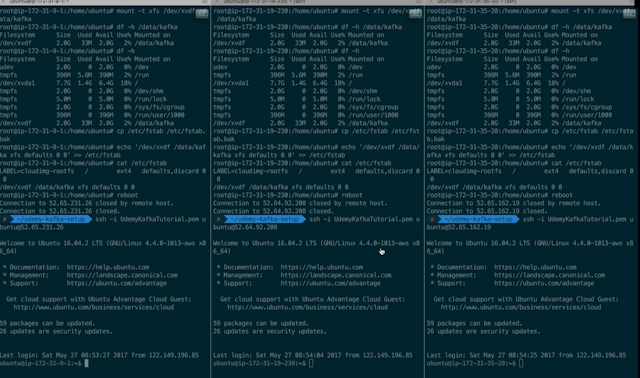1. Apply same operations to the other machines
2. Edit configurations to make sure the broker ids are different
3. Launch Cluster, observe the logs
4. Verify in Zookeeper that all three brokers are registered
#!/bin/bash
# Make sure you have done the steps from 5 on all machines
# we repeat the steps from 6
# Add file limits configs - allow to open 100,000 file descriptors
echo "* hard nofile 100000
* soft nofile 100000" | sudo tee --append /etc/security/limits.conf
sudo reboot
sudo service zookeeper start
sudo chown -R ubuntu:ubuntu /data/kafka
# edit the config
rm config/server.properties
# MAKE SURE TO USE ANOTHER BROKER ID
nano config/server.properties
# launch kafka - make sure things look okay
bin/kafka-server-start.sh config/server.properties
# Install Kafka boot scripts
sudo nano /etc/init.d/kafka
sudo chmod +x /etc/init.d/kafka
sudo chown root:root /etc/init.d/kafka
# you can safely ignore the warning
sudo update-rc.d kafka defaults
# start kafka
sudo service kafka start
# verify it's working
nc -vz localhost 9092
# look at the logs
cat /home/ubuntu/kafka/logs/server.log
# make sure to fix the __consumer_offsets topic
bin/kafka-topics.sh --zookeeper zookeeper1:2181/kafka --config min.insync.replicas=1 --topic __consumer_offsets --alter
# read the topic on broker 1 by connecting to broker 2!
bin/kafka-console-consumer.sh --bootstrap-server kafka2:9092 --topic first_topic --from-beginning
# DO THE SAME FOR BROKER 3
# After, you should see three brokers here
bin/zookeeper-shell.sh localhost:2181
ls /kafka/brokers/ids
# you can also check the zoonavigator UI















